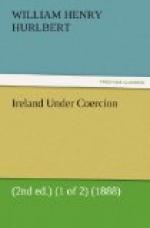At Rutland Square the crowd was tightly packed, but perfectly well-behaved, and the guests were enthusiastically cheered. But even before they had entered the house of Mr. Walker it began to break up, and long files of people wended their way to see “the carriages” hastening with their lovely freight to the Castle. Thither Lord Ernest has just gone, arrayed in a captivating Court costume of black velvet, with cut-steel buttons, sword, and buckles—just the dress in which Washington used to receive his guests at the White House, and in which Senator Seward, I remember, insisted in 1860 on getting himself presented by Mr. Dallas to Queen Victoria at Buckingham Palace.
CHAPTER II.
SION HOUSE, COUNTY TYRONE, Feb. 3d.—Hearing nothing from Mr. Davitt yesterday, I gave up the idea of attending the Ripon-Morley meeting last night. As I have come to Ireland to hear what people living in Ireland have to say about Irish affairs, I see no particular advantage in listening to imported eloquence on the subject, even from so clever a man as his books prove Mr. Morley to be, and from so conscientious a man as an acquaintance, going back to the days when he sat with Kingsley at the feet of Maurice, makes me believe Lord Ripon to be. How much either of them knows about Ireland is another matter. A sarcastic Nationalist acquaintance of mine, with whom I conversed about the visitors yesterday, assured me it had been arranged that Lord Ripon should wear the Star of the Garter, “so the people might know him from Morley.” When I observed that Dublin must have a short memory to forget so soon the face of a Chief Secretary, he replied: “Forget his face? Why, they never saw his face! It’s little enough he was here, and indoors he kept when here he was. He shook hands last night with more Irishmen than ever he spoke to while he was Chief Secretary; for he used to say then, I am told, in the Reform Club, that the only way to get along with the Irish was to have nothing to do with them!”
There was a sharp discussion, I was told, in the private councils of the Committee yesterday as to whether the Queen should be “boycotted,” and the loyal sentiments usual in connection with her Majesty’s name dropped from the proceedings. I believe it was finally settled that this might put the guests into an awkward position, both of them having worn her Majesty’s uniform of State as public servants of the Crown.
During the day I walked through many of the worst quarters of Dublin. I met fewer beggars in proportion than one encounters in such parts of London as South Kensington and other residential regions not over-frequented by the perambulating policemen; but I was struck by the number of persons—and particularly of women—who wore that most pathetic of all the liveries of distress, “the look of having seen better days.” In the most wretched streets I traversed there was more squalor than suffering—the dirtiest and most ragged people in them showing no signs of starvation, or even of insufficient rations; and certainly in the most dismal alleys and by-streets, I came upon nothing so revolting as the hives of crowded misery which make certain of the tenement house quarters of New York more gruesome than the Cour des Miracles itself used to be.




